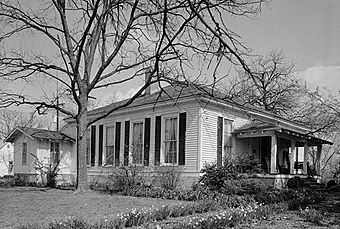Lucius Q. C. Lamar House facts for kids
|
Lucius Q. C. Lamar House
|
|

Lucius Q. C. Lamar House in 1975
|
|
| Location | 616 North 14th Street, Oxford, Mississippi |
|---|---|
| Built | 1869 |
| NRHP reference No. | 75001048 |
Quick facts for kids Significant dates |
|
| Added to NRHP | May 15, 1975 |
| Designated NHL | May 15, 1975 |
The Lucius Quintus Cincinnatus Lamar House is a special historic house museum located at 616 North 14th Street in Oxford, Mississippi. It helps people learn about the life of a famous 19th-century leader named L.Q.C. Lamar. The museum also wants to inspire young people to become good leaders today. You can visit the house for free on Fridays, Saturdays, and Sundays from 1 to 4 PM. This house was recognized as a very important place, a National Historic Landmark, in 1975.
Contents
About Lucius Q. C. Lamar
The Lucius Q. C. Lamar House is important because of its connection to Lucius Quintus Cincinnatus Lamar II. He lived here when he was a member of the U.S. Congress and later a cabinet member. Lamar was very active in American politics. He left Congress in January 1861. He helped write the Mississippi Secession Ordinance and served as a cavalry officer during the Civil War.
Lamar's Political Career
After the Civil War, Lamar became a Congressman again in 1872. He later served as the Secretary of the Interior. This job meant he was in charge of many important things for the country. After that, he became a justice on the Supreme Court. This is the highest court in the United States. Lamar was known for promoting new industries. He also helped the Southern states regain their political standing after the Civil War.
History of the House
Lucius and Virginia Lamar built this house in 1869. Lucius Lamar owned it until about 1888. While he was growing his law practice in Oxford, Mississippi, this house was his family's main home. Later, when he was in the U.S. House of Representatives, it became a quiet place for him to stay.
Ownership Changes
In 1888, Lamar gave the house to his oldest daughter, Fannie L. Mayes. Over many years, the house was not well cared for and started to fall apart. Because of its historical importance, the house was added to the National Register of Historic Places in 1975. It was also named a National Historic Landmark in the same year.
Saving the Lamar House
By the year 2000, the Lamar House was in danger of being lost. It was put on the Mississippi Heritage Trust's "Ten Most Endangered List." This meant it was at risk of "demolition by neglect," which happens when a building is left to decay.
Restoration Efforts
To save the house, the Oxford-Lafayette County Heritage Foundation bought it in 2004. They used money provided by the Mississippi Legislature. Later that year, the house was recognized as an important landmark for both Mississippi and Oxford. Three years later, in 2007, the work to restore the Lamar House began.
The restoration cost about $1.5 million. It started in May 2007 and finished in June 2008. The work included clearing the three-acre property of unwanted plants. They also replaced the house's foundation and roof. The inside of the house was also restored, including special hand-painted designs in the main hallway. Bill Russell, a member of the Oxford-Lafayette County Heritage Foundation, was a big supporter of this project. He helped lead and watch over much of the restoration work.
Images for kids
See also
 In Spanish: Casa Lucius Q. C. Lamar para niños
In Spanish: Casa Lucius Q. C. Lamar para niños




